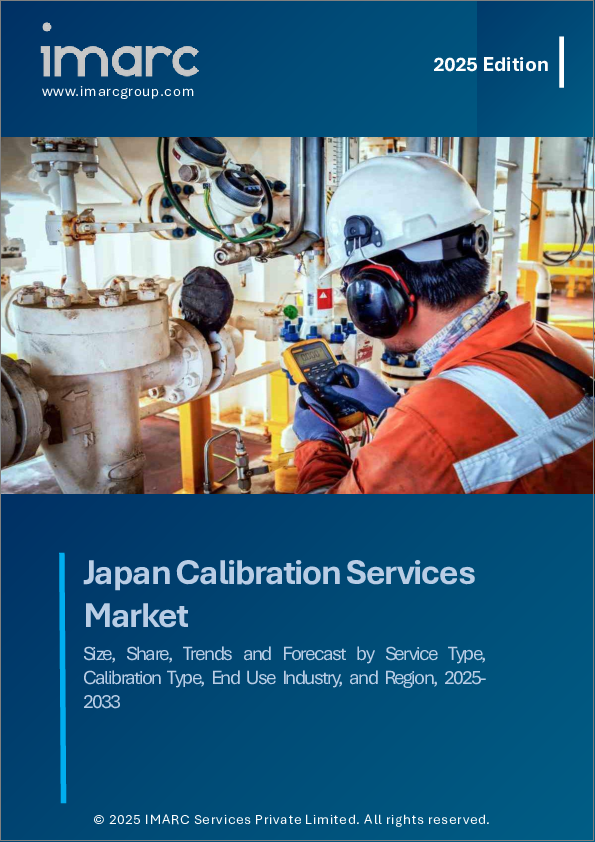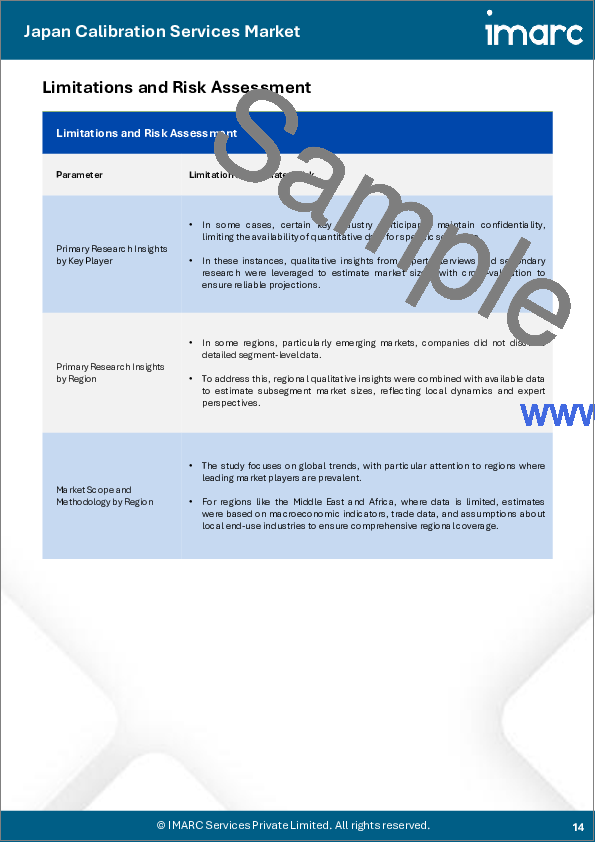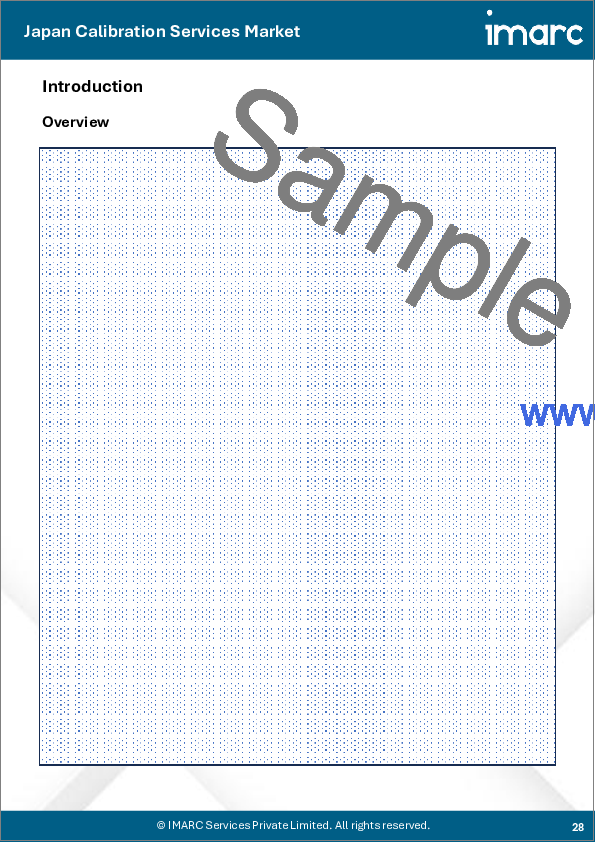|
|
市場調査レポート
商品コード
1747107
日本の校正サービス市場規模、シェア、動向、予測:サービスタイプ、校正タイプ、最終用途産業、地域別、2025年~2033年Japan Calibration Services Market Size, Share, Trends and Forecast by Service Type, Calibration Type, End Use Industry, and Region, 2025-2033 |
||||||
カスタマイズ可能
|
|||||||
| 日本の校正サービス市場規模、シェア、動向、予測:サービスタイプ、校正タイプ、最終用途産業、地域別、2025年~2033年 |
|
出版日: 2025年06月02日
発行: IMARC
ページ情報: 英文 116 Pages
納期: 5~7営業日
|
全表示
- 概要
- 目次
日本の校正サービス市場規模は2024年に3億7,480万米ドルに達しました。今後、IMARC Groupは、同市場が2033年までに5億5,640万米ドルに達し、2025年から2033年にかけて4.2%の成長率(CAGR)を示すと予測しています。同市場は、産業オートメーション、精密製造、高品質規格への準拠の必要性などの技術開発に後押しされ、一貫した成長を遂げています。さらに、自動車、エレクトロニクス、ヘルスケアなどの分野が原動力となっており、正確な校正ソリューションが求められています。
本レポートで扱う主な質問
- 日本の校正サービス市場はこれまでどのように推移し、今後どのように推移するのか?
- 日本の校正サービス市場のサービスタイプ別区分は?
- 日本の校正サービス市場の校正タイプ別区分は?
- 日本の校正サービス市場の最終用途産業別区分は?
- 日本の校正サービス市場のバリューチェーンにおける様々なステージとは?
- 日本の校正サービス市場の主な促進要因と課題は?
- 日本の校正サービス市場の構造と主要企業は?
- 日本の校正サービス市場の競合状況は?
目次
第1章 序文
第2章 調査範囲と調査手法
- 調査の目的
- ステークホルダー
- データソース
- 市場推定
- 調査手法
第3章 エグゼクティブサマリー
第4章 日本の校正サービス市場-イントロダクション
- 概要
- 市場力学
- 業界動向
- 競合情報
第5章 日本の校正サービス市場情勢
- 過去および現在の市場動向(2019~2024年)
- 市場予測(2025~2033年)
第6章 日本の校正サービス市場- サービスタイプ別の内訳
- 社内
- OEM
- サードパーティサービス
第7章 日本の校正サービス市場- キャリブレーションタイプ別の内訳
- 電気
- 機械
- 熱力学
- 物理的/次元的
- その他
第8章 日本の校正サービス市場- 最終用途産業別の内訳
- 電子機器製造
- コミュニケーション
- 航空宇宙および防衛
- 自動車
- その他
第9章 日本の校正サービス市場-競合情勢
- 概要
- 市場構造
- 市場企業のポジショニング
- 主要成功戦略
- 競合ダッシュボード
- 企業評価象限
第10章 主要企業のプロファイル
第11章 日本の校正サービス市場- 業界分析
- 促進要因・抑制要因・機会
- ポーターのファイブフォース分析
- バリューチェーン分析
第12章 付録
The Japan calibration services market size reached USD 374.8 Million in 2024. Looking forward, IMARC Group expects the market to reach USD 556.4 Million by 2033, exhibiting a growth rate (CAGR) of 4.2% during 2025-2033. The market is experiencing consistent growth, fueled by technological developments in industrial automation, precision manufacturing, and the need for compliance with high-quality standards. Moreover, sectors like automotive, electronics, and healthcare are driving forces, and they demand accurate calibration solutions.
Japan Calibration Services Market Trends:
Rising Demand in Precision Manufacturing
Japanese precision engineering is a principal cause of calibration service growth. Japan is widely renowned for being at the cutting edge of manufacturing technology, particularly in the auto, robotics, and electronics sectors. As the sectors become increasingly dependent on computerized systems, sensors, and sophisticated equipment, the need for precise calibration to ensure accuracy and reliability increases. Calibration services are an important aspect of maintaining the performance of high-technology equipment used in production lines, assembly plants, and research laboratories. Due to Japan's industrial setup with a focus on zero-defect manufacturing, calibration services are an essential part of the process to prevent faults and downtime. For instance, automobile manufacturers are investing more in advanced systems that require frequent calibration to meet global quality standards. Japan's providers of calibration services are expanding their portfolios to deliver end-to-end solutions that cover on-site calibration, system integration, and in-house staff calibration training. More manufacturers are increasing their focus on automation and aiming to optimize the efficiency of their production, making the demand for precise and credible calibration services more likely to increase.
Technological Advancements and Compliance Requirements
Technological advancement is one of the most important drivers of Japan's calibration services sector, particularly with increased instrument and test equipment complexity. The sectors are using more complicated tools that require high-level calibration to meet particular standards. Electronic and automated calibration services have opened up faster and more accurate services, which make the calibration process more efficient. All of these technologies have been applied to meet the ever-growing needs of industries like energy, electronics, and telecommunications, where precision and accuracy are paramount. Additionally, the strict regulatory aspect of product quality, environmental standards, and quality management systems on the part of Japan is an important facilitator. Businesses are being pressed more and more to meet international standards like ISO 9001 and ISO 17025. These regulatory needs call for periodic calibration of measuring instruments and test equipment. Calibration service providers are addressing this requirement by offering tailor-made services that guarantee regulatory compliance. An evolving regulatory landscape, coupled with calibration technology advancements, is creating new opportunities for calibration service providers. As companies aim for more efficient production while being subject to strict standards, calibration services will likely be a critical component of Japan's industrial environment.
Japan Calibration Services Market Segmentation:
Service Type Insights:
- In-House
- OEMs
- Third-Party Service
Calibration Type Insights:
- Electrical
- Mechanical
- Thermodynamic
- Physical/Dimensional
- Others
End Use Industry Insights:
- Electronics Manufacturing
- Communication
- Aerospace and Defense
- Automotive
- Others
Competitive Landscape:
The market research report has also provided a comprehensive analysis of the competitive landscape. Competitive analysis such as market structure, key player positioning, top winning strategies, competitive dashboard, and company evaluation quadrant has been covered in the report. Also, detailed profiles of all major companies have been provided.
Key Questions Answered in This Report:
- How has the Japan calibration services market performed so far and how will it perform in the coming years?
- What is the breakup of the Japan calibration services market on the basis of service type?
- What is the breakup of the Japan calibration services market on the basis of calibration type?
- What is the breakup of the Japan calibration services market on the basis of end use industry?
- What are the various stages in the value chain of the Japan calibration services market?
- What are the key driving factors and challenges in the Japan calibration services market?
- What is the structure of the Japan calibration services market and who are the key players?
- What is the degree of competition in the Japan calibration services market?
Table of Contents
1 Preface
2 Scope and Methodology
- 2.1 Objectives of the Study
- 2.2 Stakeholders
- 2.3 Data Sources
- 2.3.1 Primary Sources
- 2.3.2 Secondary Sources
- 2.4 Market Estimation
- 2.4.1 Bottom-Up Approach
- 2.4.2 Top-Down Approach
- 2.5 Forecasting Methodology
3 Executive Summary
4 Japan Calibration Services Market - Introduction
- 4.1 Overview
- 4.2 Market Dynamics
- 4.3 Industry Trends
- 4.4 Competitive Intelligence
5 Japan Calibration Services Market Landscape
- 5.1 Historical and Current Market Trends (2019-2024)
- 5.2 Market Forecast (2025-2033)
6 Japan Calibration Services Market - Breakup by Service Type
- 6.1 In-House
- 6.1.1 Overview
- 6.1.2 Historical and Current Market Trends (2019-2024)
- 6.1.3 Market Forecast (2025-2033)
- 6.2 OEMs
- 6.2.1 Overview
- 6.2.2 Historical and Current Market Trends (2019-2024)
- 6.2.3 Market Forecast (2025-2033)
- 6.3 Third-Party Service
- 6.3.1 Overview
- 6.3.2 Historical and Current Market Trends (2019-2024)
- 6.3.3 Market Forecast (2025-2033)
7 Japan Calibration Services Market - Breakup by Calibration Type
- 7.1 Electrical
- 7.1.1 Overview
- 7.1.2 Historical and Current Market Trends (2019-2024)
- 7.1.3 Market Forecast (2025-2033)
- 7.2 Mechanical
- 7.2.1 Overview
- 7.2.2 Historical and Current Market Trends (2019-2024)
- 7.2.3 Market Forecast (2025-2033)
- 7.3 Thermodynamic
- 7.3.1 Overview
- 7.3.2 Historical and Current Market Trends (2019-2024)
- 7.3.3 Market Forecast (2025-2033)
- 7.4 Physical/Dimensional
- 7.4.1 Overview
- 7.4.2 Historical and Current Market Trends (2019-2024)
- 7.4.3 Market Forecast (2025-2033)
- 7.5 Others
- 7.5.1 Historical and Current Market Trends (2019-2024)
- 7.5.2 Market Forecast (2025-2033)
8 Japan Calibration Services Market - Breakup by End Use Industry
- 8.1 Electronics Manufacturing
- 8.1.1 Overview
- 8.1.2 Historical and Current Market Trends (2019-2024)
- 8.1.3 Market Forecast (2025-2033)
- 8.2 Communication
- 8.2.1 Overview
- 8.2.2 Historical and Current Market Trends (2019-2024)
- 8.2.3 Market Forecast (2025-2033)
- 8.3 Aerospace and Defense
- 8.3.1 Overview
- 8.3.2 Historical and Current Market Trends (2019-2024)
- 8.3.3 Market Forecast (2025-2033)
- 8.4 Automotive
- 8.4.1 Overview
- 8.4.2 Historical and Current Market Trends (2019-2024)
- 8.4.3 Market Forecast (2025-2033)
- 8.5 Others
- 8.5.1 Historical and Current Market Trends (2019-2024)
- 8.5.2 Market Forecast (2025-2033)
9 Japan Calibration Services Market - Competitive Landscape
- 9.1 Overview
- 9.2 Market Structure
- 9.3 Market Player Positioning
- 9.4 Top Winning Strategies
- 9.5 Competitive Dashboard
- 9.6 Company Evaluation Quadrant
10 Profiles of Key Players
- 10.1 Company A
- 10.1.1 Business Overview
- 10.1.2 Services Offered
- 10.1.3 Business Strategies
- 10.1.4 SWOT Analysis
- 10.1.5 Major News and Events
- 10.2 Company B
- 10.2.1 Business Overview
- 10.2.2 Services Offered
- 10.2.3 Business Strategies
- 10.2.4 SWOT Analysis
- 10.2.5 Major News and Events
- 10.3 Company C
- 10.3.1 Business Overview
- 10.3.2 Services Offered
- 10.3.3 Business Strategies
- 10.3.4 SWOT Analysis
- 10.3.5 Major News and Events
- 10.4 Company D
- 10.4.1 Business Overview
- 10.4.2 Services Offered
- 10.4.3 Business Strategies
- 10.4.4 SWOT Analysis
- 10.4.5 Major News and Events
- 10.5 Company E
- 10.5.1 Business Overview
- 10.5.2 Services Offered
- 10.5.3 Business Strategies
- 10.5.4 SWOT Analysis
- 10.5.5 Major News and Events
11 Japan Calibration Services Market - Industry Analysis
- 11.1 Drivers, Restraints, and Opportunities
- 11.1.1 Overview
- 11.1.2 Drivers
- 11.1.3 Restraints
- 11.1.4 Opportunities
- 11.2 Porters Five Forces Analysis
- 11.2.1 Overview
- 11.2.2 Bargaining Power of Buyers
- 11.2.3 Bargaining Power of Suppliers
- 11.2.4 Degree of Competition
- 11.2.5 Threat of New Entrants
- 11.2.6 Threat of Substitutes
- 11.3 Value Chain Analysis





